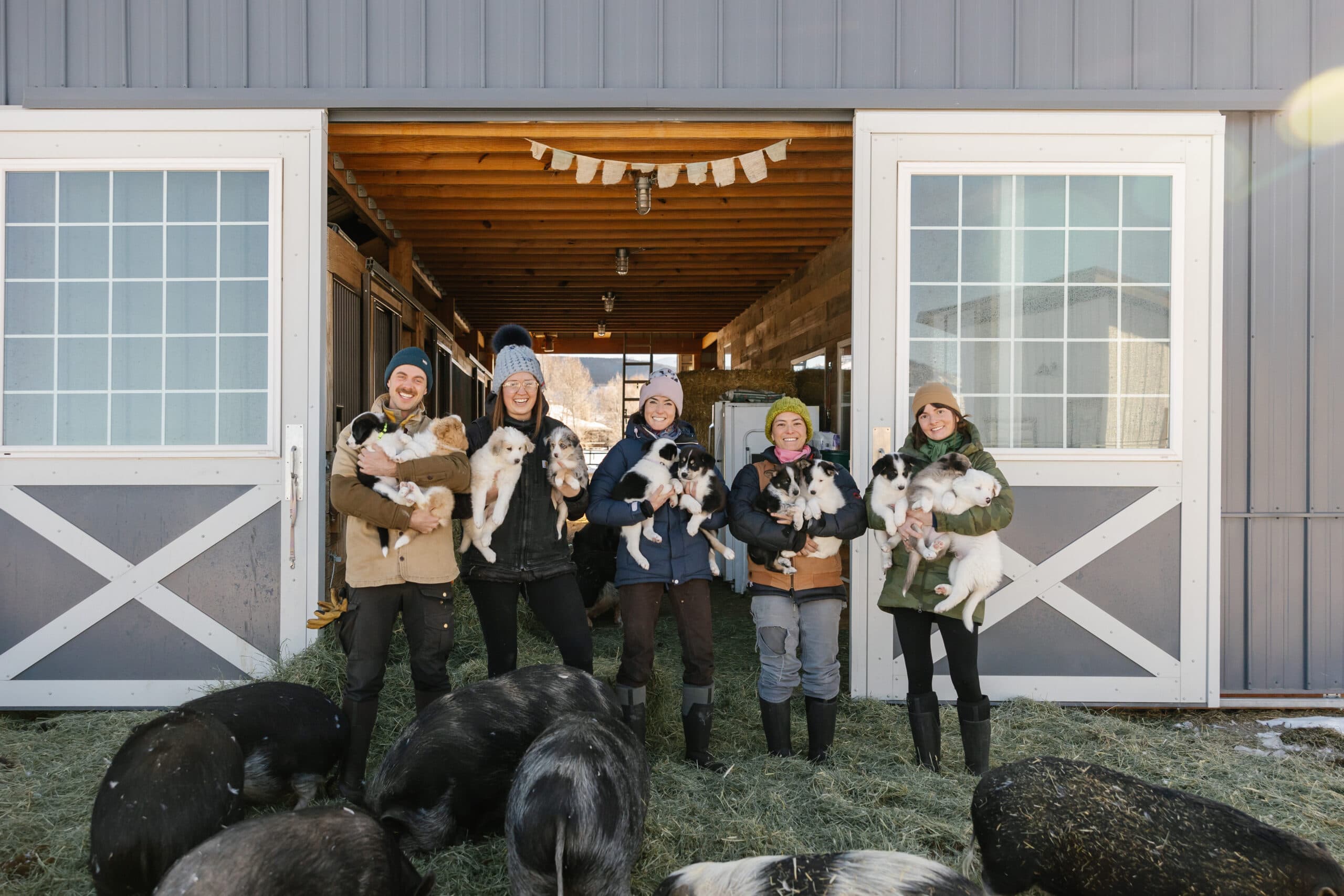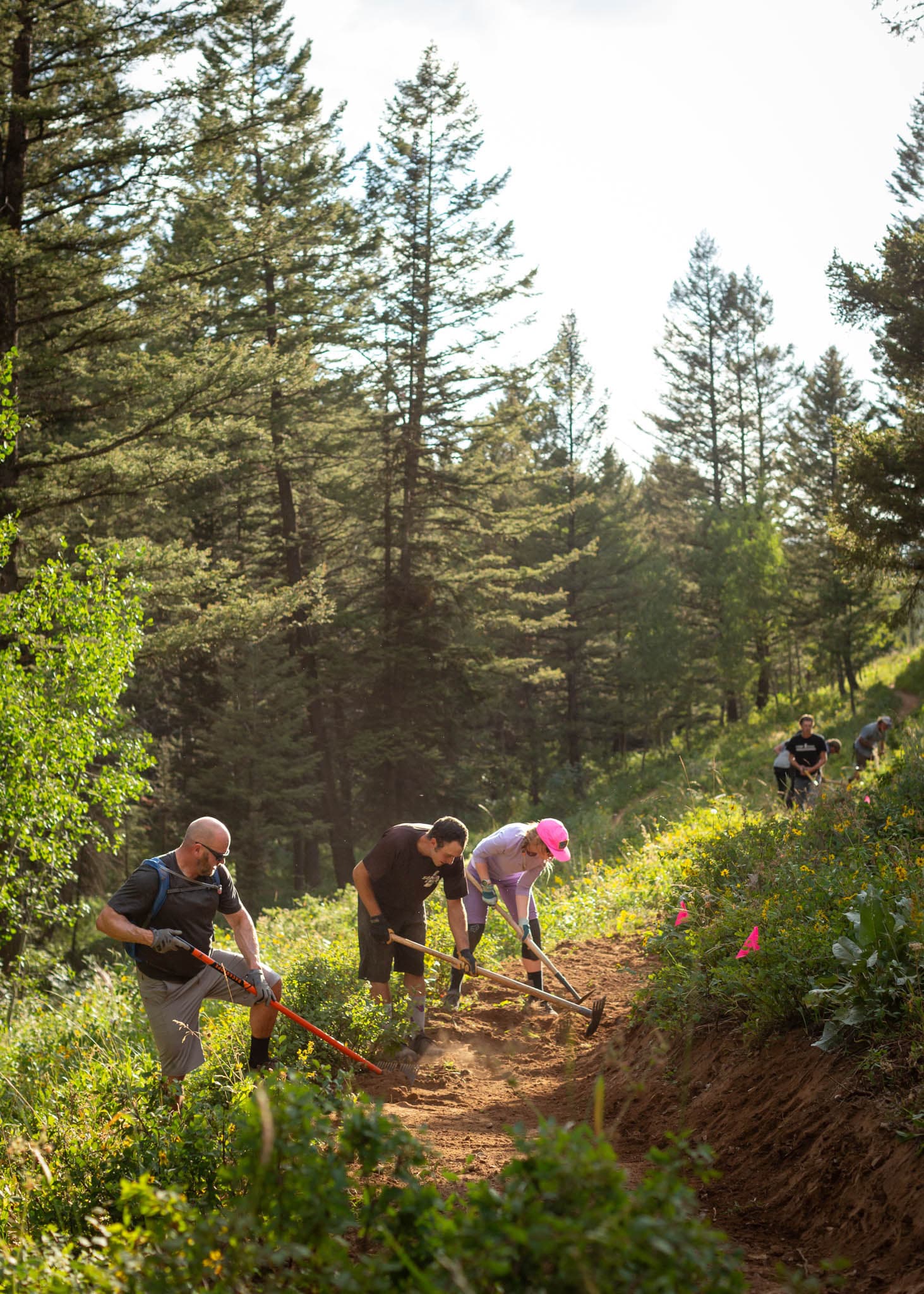Into Our Herds and Hearts
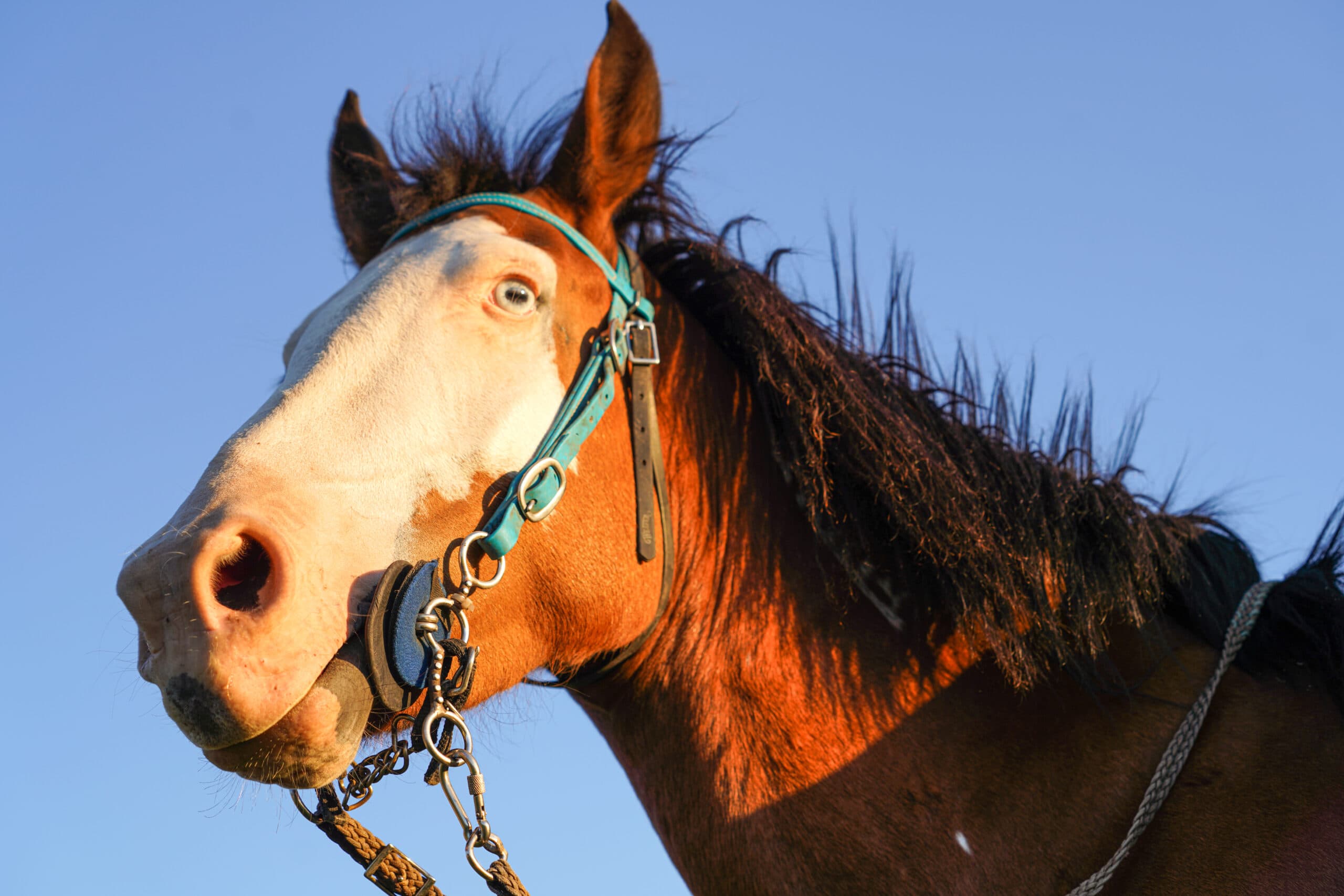
Teton Valley residents and their mustangs
Like a loud, fast, airborne cowboy, the helicopter pilot swoops low across the dry, sage-covered rangeland, moving the wave of wild horses. Small bands of mustangs below the helicopter run toward the temporary chute in the middle of the barren landscape. As the horses near the chute, their movements synchronize—stallions, mares, foals, all galloping in the same direction. The wave of hooves and dust breaks at the end of the corral panels. The horses are trapped. They spin, rear, kick—chaos contained by tall temporary corral panels while the helicopter hovers low, blocking their return to the rangeland. With only one direction for the horses to escape the pressure of the panels and the helicopter, they run, stumble, and leap through the wide opening and into the confines of the waiting stock trailer.
Multiple times a year across the West, the Bureau of Land Management (BLM) performs these drive-trap gathers to reduce the number of free-roaming horses living on federal lands. An estimated eighty thousand mustangs currently live across the cumulative 26.9 million acres of herd management areas (HMAs). The goal is to attain more sustainable herd sizes that create a balance for all the demands on the range, including cattle ranching, recreationists, and energy development. The BLM has pegged the appropriate management level at a total of twenty-seven thousand horses—meaning there’s a surplus of more than fifty thousand mustangs. With the horses’ lack of natural predators and high reproduction rate, along with competing demands for land use, the BLM wrestles with the management options for this mustang population.
For the mustangs removed from the range, their wild lives transition to a confined journey. After their capture, the horses are transported to a BLM holding facility where they are branded, vaccinated, and castrated in preparation for adoption. Today, the BLM holds more than fifty thousand mustangs in corrals awaiting adoption, and the number continues to grow with each gathering operation. Adoptions are nowhere near keeping pace with the removal numbers. The annual cost for these horses as wards of the BLM is $49 million.
Partnerships between the BLM and private organizations are working to address the challenges. Inmates at correctional facilities participate in training mustangs, 4-H students gentle yearlings to be auctioned at state fairs, and horse trainers take on the popular “Extreme Mustang Makeover” challenge, a competition with the Mustang Heritage Foundation to showcase the beauty, versatility, and trainability of American mustangs.
A number of Teton Valley residents have also joined in the mission to create a home and life for these mustangs. The once wild horses have become a part of many local herds and hearts. Here are just a few of their stories:
The petite bay pinto mare stands quietly, her lead loosely tied to the hitching post at Linn Canyon Ranch. Braiden Klingler has just returned from guiding a trail ride on Rosey. He hoses her off on the hot summer afternoon as she keeps close watch with her glass-blue eyes.
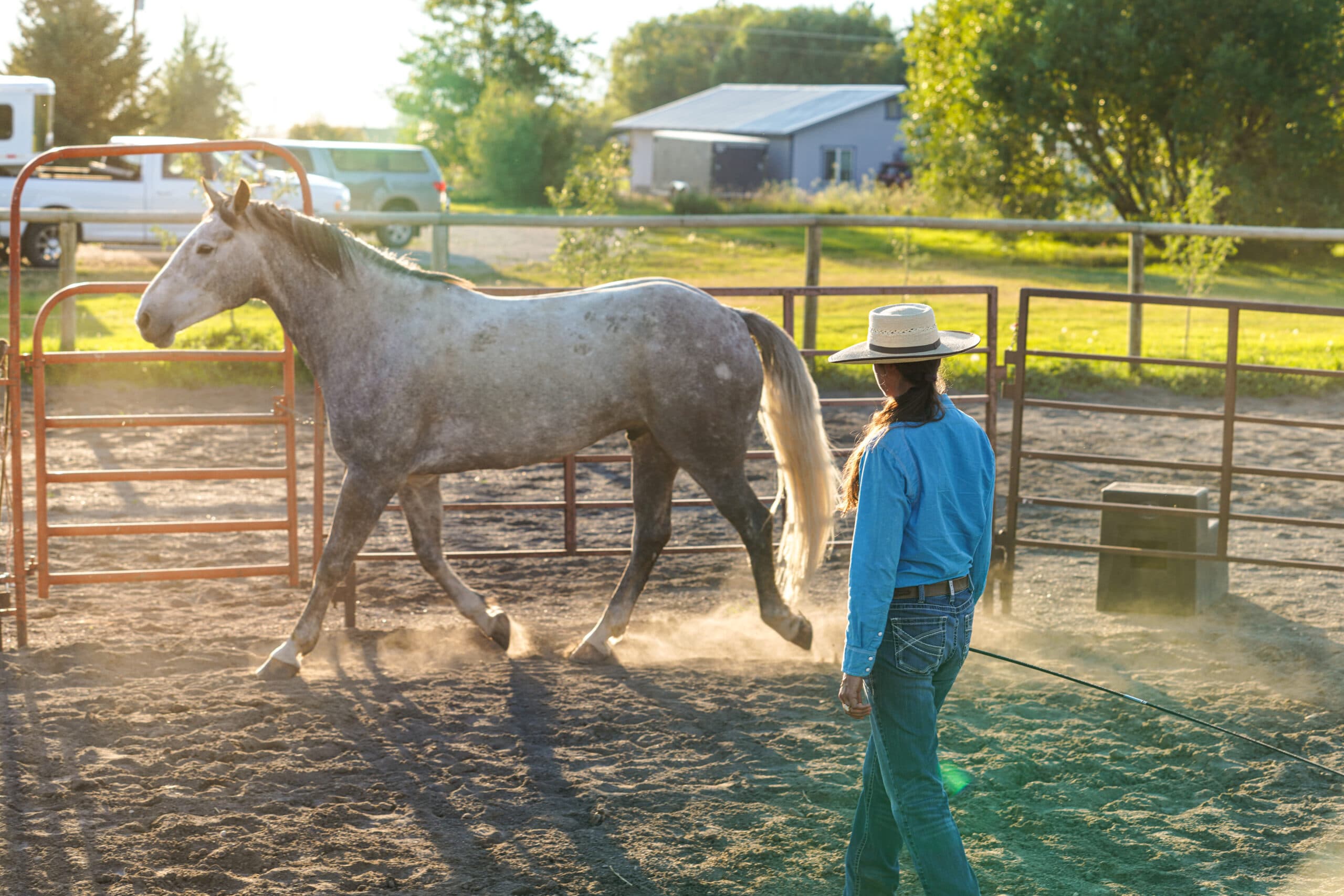
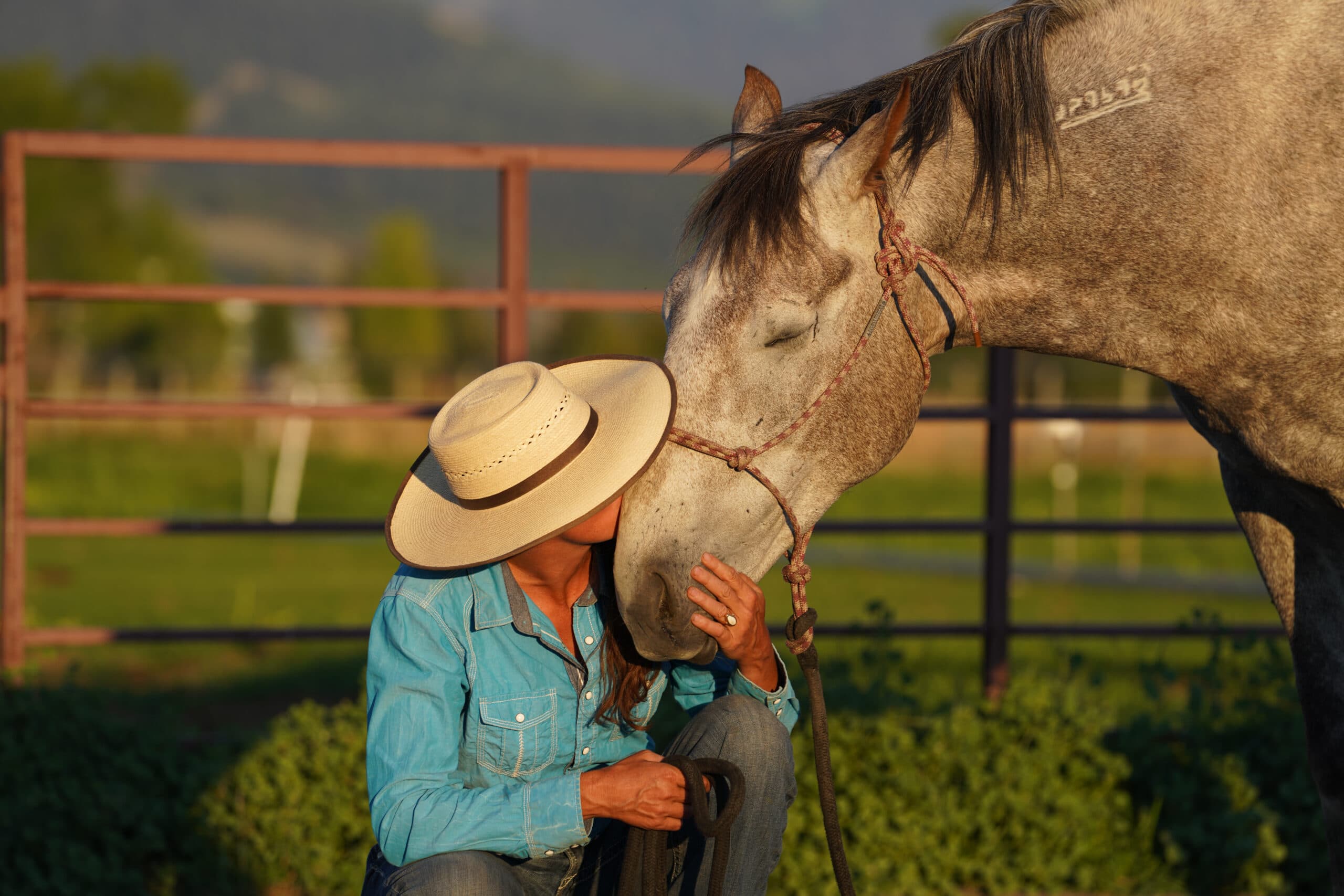


The young mustang has recently started to guide trail rides. Five years ago, she was born in a BLM holding facility to a mare that was pregnant when gathered from the Divide Basin HMA northeast of Rock Springs, Wyoming. Braiden says mustangs from Divide Basin tend to have a larger body size. “Most of the Divide Basin horses are known to have bloodlines with traces of draft horse, also known as work horses,” he says, a trait he appreciates in his horses. Although born in captivity, Rosey’s wildness is still very present; the bloodlines of wild horses can be evident compared to other horses in their thicker coats, harder hooves, and heightened awareness.
Rosey’s training is progressing well under saddle, and Braiden is quick to say that he’s been lucky with what he’s got. When he references “what he’s got,” he means the two mustangs he has owned through the 4-H BLM project. But ask others around Teton Valley, and they will tell you what Braiden has is more than luck with picking mustangs. Some recognize Braiden as the trick rider from the Teton Valley Rodeo, while others have met him through Linn Canyon Ranch. What the young man, born and raised in Teton Valley, “has got” is a kind and humble way with horses.
Braiden started training mustangs in 2015, still in high school, when his cousin suggested they do the BLM mustang project for their final year of 4-H. After spending the summer gentling his first yearling, which includes haltering, leading, and desensitizing, Braiden had the young mustang ready for the 4-H adoption event at the East Idaho State Fair. Braiden bid on his own horse, and Indie went back home with him.
Today, Rosey is Braiden’s second mustang. In 2018, after the tragic loss of Indie, Braiden returned to the East Idaho State Fair and bid on the yearling trained by another 4-H student. He was the only one to bid on her.
Braiden spent the next year continuing ground work with Rosey. “The thing for me is building a connection between you and the horse at a young age,” he says. “You have to take the time to learn how they think and feed through their energy, that way you can build a stronger bond.” When it was time to saddle train her, the bond was solid, and the process was easy. “The first time I sat on her she just stood, never cared at all. She’s been super easy to work with,” Braiden says.
Their training continues to progress with every trail ride. Braiden appreciates the mustang’s qualities for mountain trail riding; he notices they are less skittish than domesticated horses in the backcountry. But that doesn’t
always mean it’s easy. While Braiden acknowledges that Rosey is hard working and learns quickly, she can be stubborn at times. His best training tip is one word—patience.
Standing in the scant shade of the shelter, the seven-year-old bay gelding swats flies with his tail. He chews casually on his hay in the heat of the afternoon. Mara Kingscott enters the pasture, and Arrow gives a look but stays put. Mara quietly slips the rope halter over the mustang’s head and gives him a quick rub on the forehead.
Arrow was rounded up five years earlier from the Maverick Medicine HMA located fifty miles outside of Elko, Nevada. The young mustang was placed in the Teton County 4-H program. Like Braiden, the 4-H teen who gentled Arrow also adopted her own horse at the fair. The local family kept Arrow for a couple of years but did not continue his training. In the spring of 2020, the family offered the horse to Mara, and she couldn’t refuse.
Mara never planned to get a mustang. She grew up in Michigan riding and showing English, but when she moved to Teton Valley, she grew more interested in Western performance horses. Even as an experienced rider, Mara’s training experience was limited, so when it came time for Arrow’s first ride, she handed over the reins to her roommate who was seasoned at starting colts. Mara says it “looked like so much fun” that she’s had every ride since. “We figured each other out,” she says. She has leaned on the Basic Handle method, popularized by the mustang trainer Wylene Wilson. Wylene has been a mentor to Mara as she works with Arrow to create a well-rounded horse.
Today, Mara and Arrow can often be found out riding in the mountains, but the pair also work cows and are learning to rope together. Last summer, they competed in an extreme obstacle course competition, completing twenty-one of the twenty-three obstacles in five and a half minutes, including a swinging bridge and an outhouse obstacle.
Mara’s experience with Arrow has been different than with the domesticated horses she has ridden her whole life. She echoes Braiden’s experience: Arrow is a lot more stubborn and asks “Why?” more than any other horse she’s owned. Through this experience, she has also learned to ask “Why?” more, too. Arrow has to be convinced a bit more, so Mara makes sure it’s worth the energy to do what she is asking of him.
“He was sent to me as a challenge to teach me patience,” Mara says. She acknowledged that she has felt so much personal growth from the experience. “Anyone who thinks they’ve got a good handle on horse training should try a mustang. They will test you,” she adds, laughing.
In addition to patience, Mara has learned that she is capable of a lot more than she thought she was. She’s been lucky to have good mentors. She’s learned to slow down and not be as focused on the results. She often reminds herself of Wylene’s saying: “Set intention; release expectation.” Many times, Mara questioned if Arrow would ever become a trustworthy horse. Last summer, a maturity clicked, and she feels a new understanding between them now. Working with Arrow is a daily reminder for Mara that it’s about the journey.
Brenda Davis-Matz threw her leg over the large gray gelding for the first time and the unexpected rodeo ride of her life began. Despite her lifetime of riding horses, from racetrack Thoroughbreds to breaking horses, she had never felt this before. She knew before she even came down into the saddle—the powerful mustang’s back humped underneath her and then he rocketed. She experienced the raw power of a mustang that was unlike any other horse she’d ever ridden.
In the fall of 2020, when Brenda met the tall stocky mustang at Darwin Ranch, a remote and historic ranch nestled by an alpine river in the Gros Ventre Wilderness, she swore she had seen him before. A few years earlier, watching a handful of mustangs offload a trailer at the ranch, he stood out to her. The horse had just been purchased from a prison auction to be used as a dude horse for ranch guests. Fast forward a few years, the mustang was never put into the dude string, and it was time for him to find a new owner. Brenda purchased the horse and began her lifelong goal of training a mustang.
Growing up in Kentucky, Brenda has been a horsewoman her whole life. But in October 2020, this seven-year-old mustang from the Owyhee HMA in the Great Basin Desert of Nevada was about to introduce her to a level of horsepower she had never experienced. It was that first ride when Brenda realized she had nothing over this mustang. Fortunately, horse and rider ended up safe, but the experience left both Brenda and Ollie shaken to the core.
From that one brief experience, Brenda hit a serious confidence wall. She kept trying to work with Ollie, but acknowledged that she was terrified. Starting back with ground work, she thought they’d move past it. But what she was asking of Ollie was being lost in translation between human and the wild horse. “If you can’t help him translate, it’s like pulling against a current,” she says.
Brenda realized she couldn’t do this alone and heard about Mustang Matt on Facebook. She called Matt and asked if she could drop Ollie off for training. He replied: “His issue is with you, not with me.” Brenda understood that she and Ollie both had things to sort through.
In March 2022, Brenda and Ollie headed north to Mustang Matt’s ranch in Hamilton, Montana, for a three-day immersion. Brenda described the experience as “validating, healing, and eye opening.”
“We learned to translate and bond,” she says. “We rewired our understanding of one another.” Mustang Matt often reminded her: “Just breathe, give me the breath.” Matt helped the horse and human connect and gave Brenda tools to build on back home.
“It is an amazing moment of translation when you connect,” she says. “When you create the connection, it will be the coolest connection you’ve ever had.”
That connection is daily work. Today, Brenda and Ollie continue to build their relationship with every ride and pack trip. “I make mistakes and Ollie teaches me every day,” she says. As an energy healer and animal communicator, Brenda recognizes Ollie’s power to teach her. “He shows me something new every day, he’s my teacher right now. He reminds me I am human.”
The challenges Brenda faced with Ollie and the commitment to continue to grow has helped her understand that she had to fine tune her skills and figure out the next step. “I love how Ollie requires me as a partner to be present in every moment of our time together,” she says. “Anything else and it changes the quality of our interaction. Equally, I am so humbled with his acceptance.” Brenda says Ollie reminds her that the living experience is to grow and evolve.
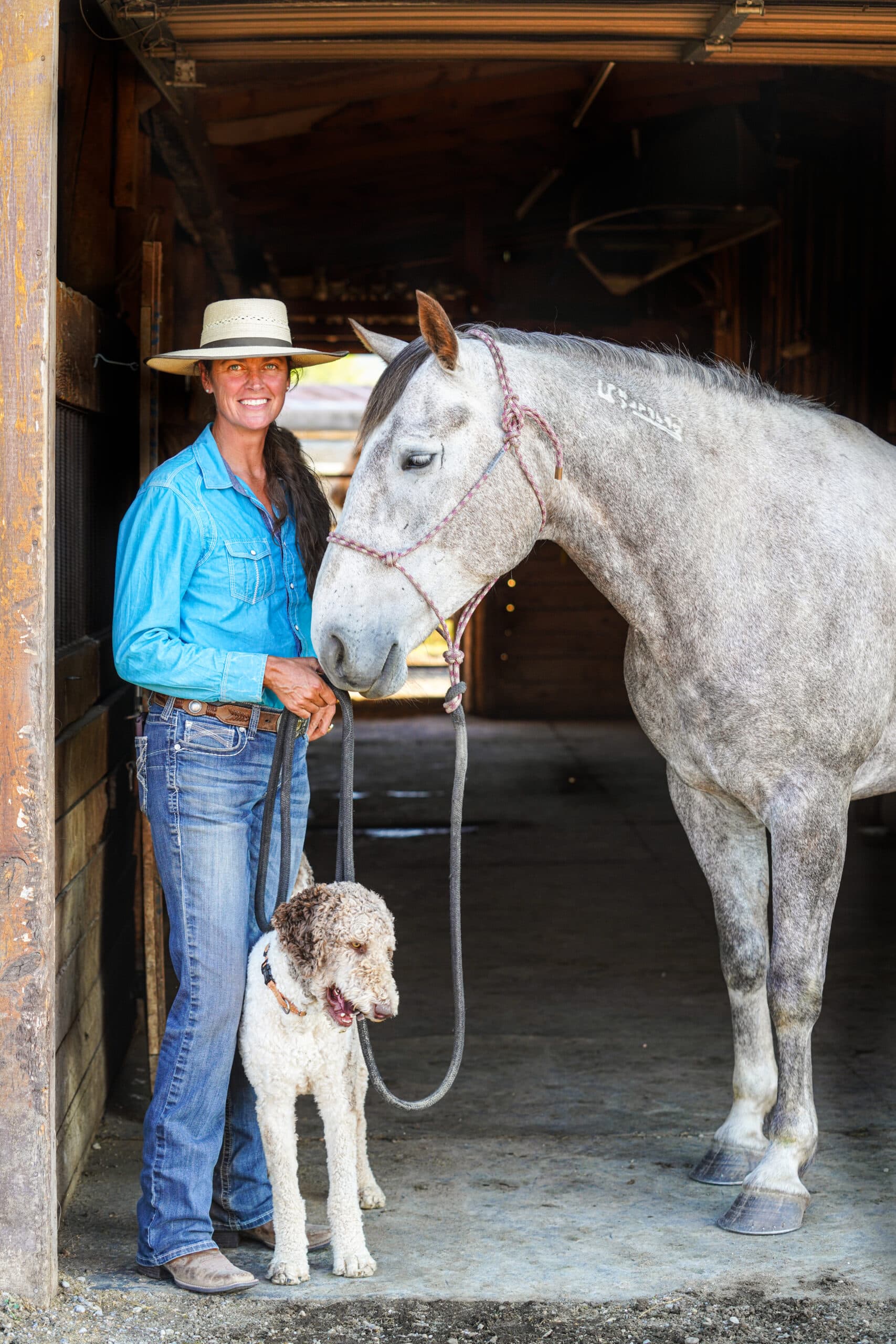
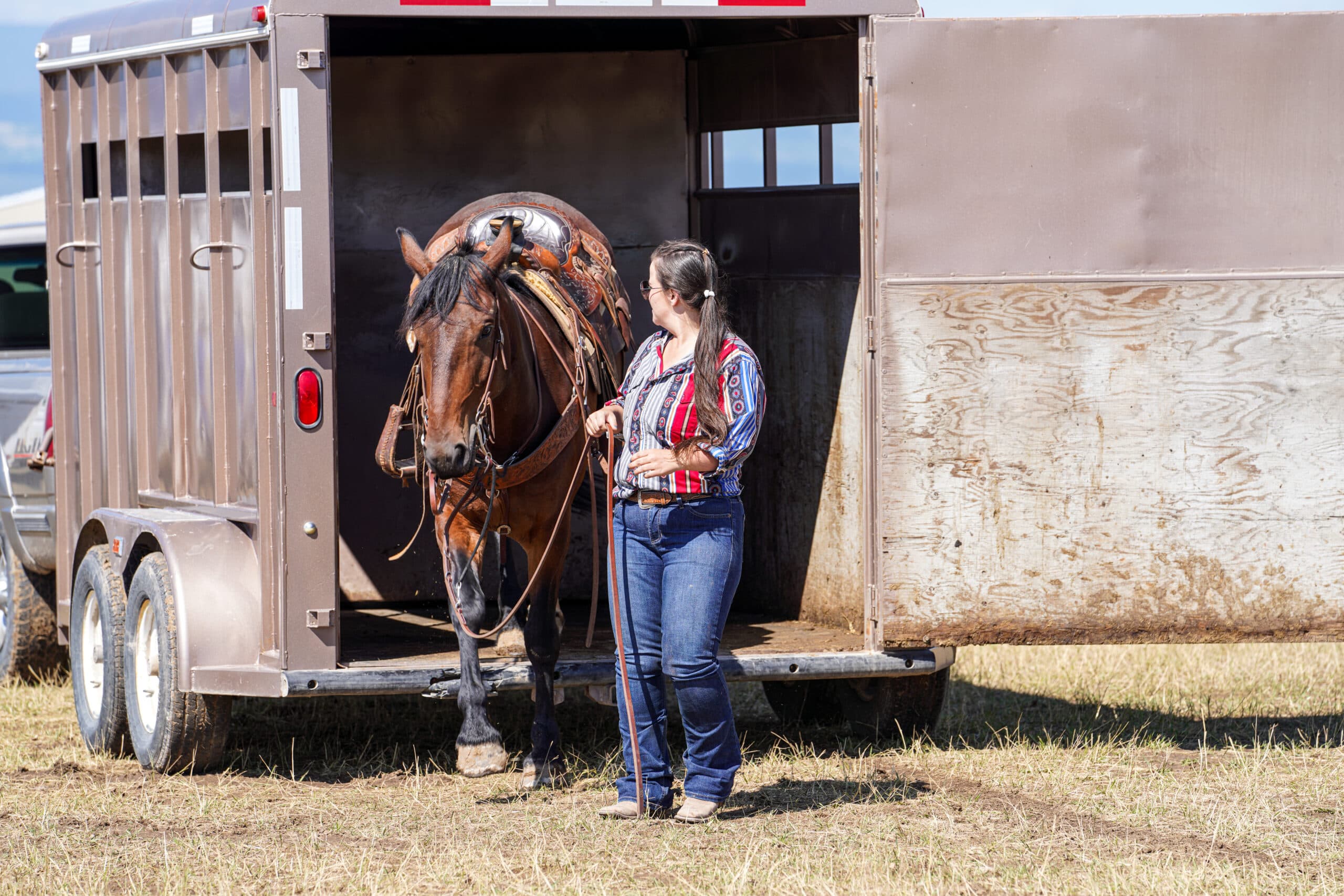
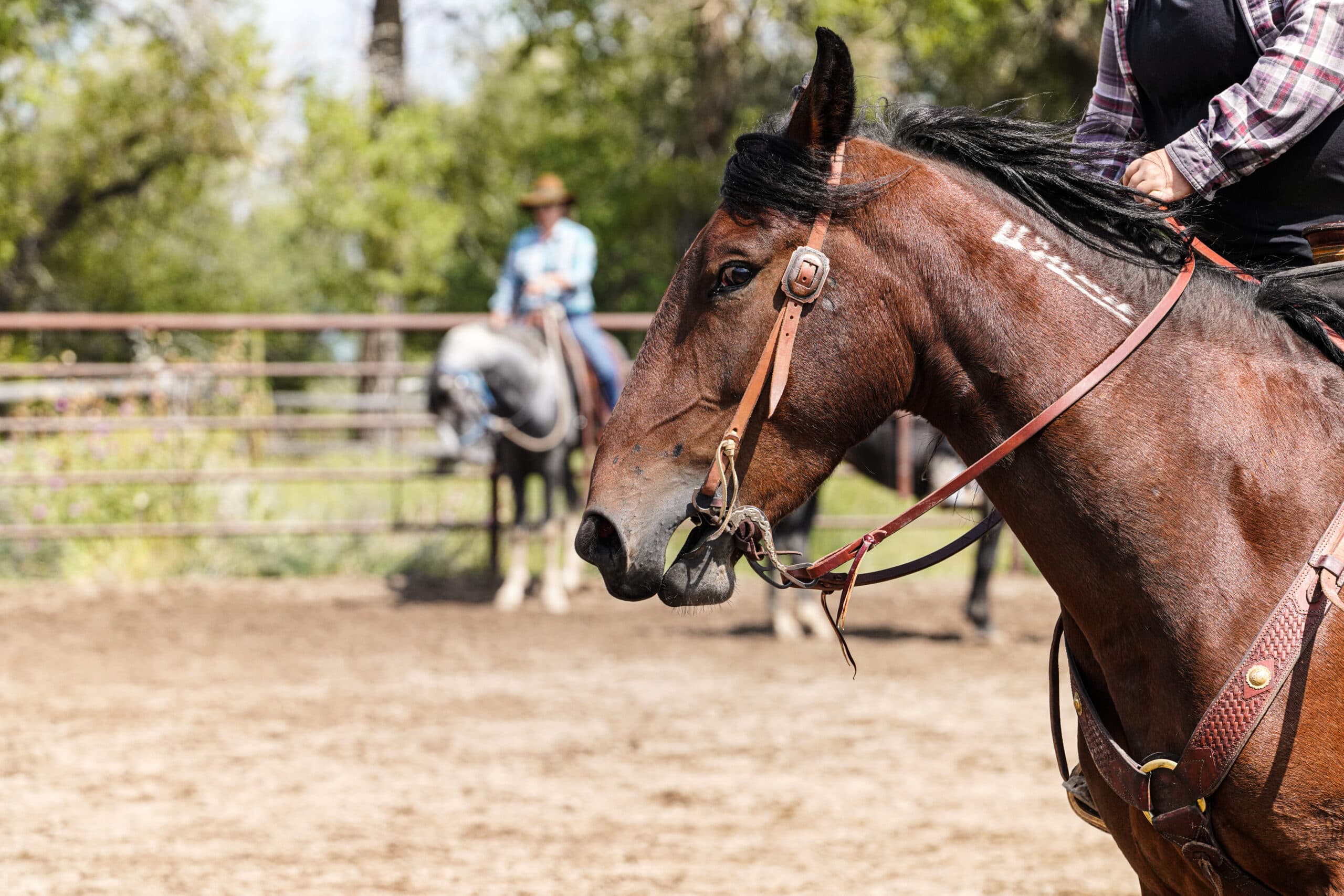

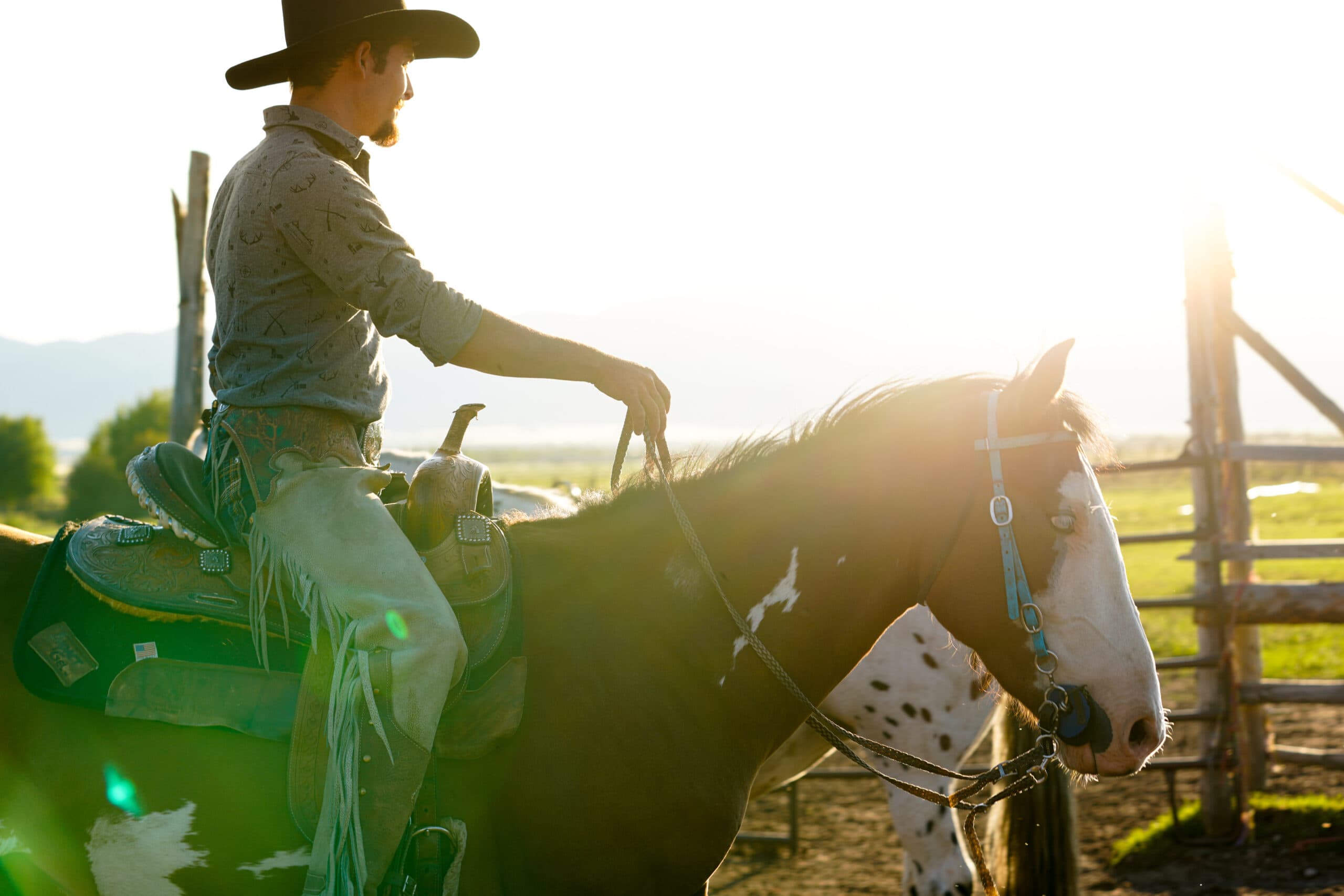
Bradien riding his Mustang in Teton Valley.
Reading a Mustang Brand
Mustangs gathered from BLM herd management areas have a freeze brand on the left side of their neck. Each mark in the brand represents a number in the Alpha Angle Code. The brand indicates the registering organization (U.S. Government), the year of birth, and the individual registration number. Mustangs gathered from Forest Service and tribal lands are not branded.
Adopting a mustang
Mustangs, both untouched and gentled, are available for sale or adoption through the BLM. The three most common ways to adopt a mustang are:
- BLM Public Off Range Corral: With an approved application, a mustang can be adopted directly from the holding facility for $125. Most of these mustangs are untouched. To promote more adoptions of untrained mustangs, the Adoption Incentive Program offers $1,000 to adopters after one year of ownership.
- TIP trained: Adopters who would like a gentled mustang with basic training can adopt through the Trainer Incentive Program (TIP). TIP trainers gentle and complete basic training with the mustangs before the horse is available for adoption.
- BLM Auctions: The BLM hosts a number of auction events throughout the year. These events are held across the country with a wide variety of horses available, from untouched to saddle trained. The events include mustang makeover competitions and 4-H trained mustangs, as well as horses trained by inmates at correctional facilities.

